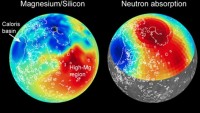NASA Confirms 1,284 Exoplanets Discovered by Kepler Space Observatory
| Arthur Dominic Villasanta | | May 10, 2016 06:49 PM EDT |
(Photo : NASA/W. Stenzel) Exoplanets discovered by Kepler (artist's concept)
The exoplanet hunting Kepler space observatory run by NASA has verified the discovery of 1,284 new exoplanets. It's the single largest finding of exoplanets to date.
NASA said an analysis of Kepler's July 2015 planet candidate catalog identified 4,302 potential planets. For 1,284 of the planet candidates, the probability of being a planet is greater than 99 percent, which is the minimum required to earn the status of "planet."
Like Us on Facebook
In addition, 1,327 candidates are more likely than not to be actual planets but don't meet the 99 percent threshold and will require additional study. The remaining 707 are likely to be some other astrophysical phenomena. This analysis also validated 984 candidates previously verified by other techniques.
Close to 550 of these newly-validated planets could be rocky planets like Earth based on their size. Nine of these exoplanets orbit in their sun's habitable or Goldilocks zone. This life-sustaining zone is the distance from a star where orbiting planets can have surface temperatures that allow liquid water to pool.
With the addition of these nine, 21 exoplanets now are known to be members of this exclusive group.
Of the nearly 5,000 total planet candidates found to date by astronomers all over the world, over 3,200 have been verified and 2,325 of these were discovered by Kepler.
This announcement of the discovery of 1,284 exoplanets is based on a statistical analysis method that can be applied to many planet candidates simultaneously, said NASA.
Timothy Morton, associate research scholar at Princeton University in New Jersey and lead author of the scientific paper published in The Astrophysical Journal, employed a technique to assign each Kepler candidate a planet-hood probability percentage. This is the first such automated computation on this scale since previous statistical techniques focused only on sub-groups within the greater list of planet candidates identified by Kepler.
Kepler was launched by NASA on March 7, 2009 to discover Earth-size exoplanets in or near habitable zones orbiting other stars in the Milky Way.
Placed in an Earth-trailing heliocentric orbit, Kepler is designed to survey a portion of our region of the Milky Way and discover exoplanets using a transit hunting method. The science instrument that hunts for exoplanets is a photometer that continually monitors the brightness of over 145,000 main sequence stars in a fixed field of view
"This announcement more than doubles the number of confirmed planets from Kepler," said Ellen Stofan, chief scientist at NASA Headquarters in Washington. "This gives us hope that somewhere out there, around a star much like ours, we can eventually discover another Earth."
"Before the Kepler space telescope launched, we did not know whether exoplanets were rare or common in the galaxy. Thanks to Kepler and the research community, we now know there could be more planets than stars," said Paul Hertz, Astrophysics Division director at NASA Headquarters.
"This knowledge informs the future missions that are needed to take us ever-closer to finding out whether we are alone in the universe."
In 2018, NASA's Transiting Exoplanet Survey Satellite will monitor 200,000 bright nearby stars and search for exoplanets, focusing on Earth and Super-Earth-sized.
TagsKepler space observatory, NASA, Exoplanets, habitable zone, photometer, Transiting Exoplanet Survey Satellite
©2015 Chinatopix All rights reserved. Do not reproduce without permission
 First USGS Digital Topographic Map of Mercury Shows Entire Surface
First USGS Digital Topographic Map of Mercury Shows Entire Surface Bonanza for U.S. firms: NASA Makes Some of its Patented Tech Freely Available
Bonanza for U.S. firms: NASA Makes Some of its Patented Tech Freely Available Menstruation in Space: Is It a Problem for Female Astronauts?
Menstruation in Space: Is It a Problem for Female Astronauts? Second Space Station to Orbit will be Inflatable
Second Space Station to Orbit will be Inflatable James Webb Space Telescope will be Mankind’s Most Powerful Time Machine
James Webb Space Telescope will be Mankind’s Most Powerful Time Machine New NASA Maps Expose More of Mercury's Secrets
New NASA Maps Expose More of Mercury's Secrets
EDITOR'S PICKS
-

Did the Trump administration just announce plans for a trade war with ‘hostile’ China and Russia?
-

US Senate passes Taiwan travel bill slammed by China
-

As Yan Sihong’s family grieves, here are other Chinese students who went missing abroad. Some have never been found
-

Beijing blasts Western critics who ‘smear China’ with the term sharp power
-

China Envoy Seeks to Defuse Tensions With U.S. as a Trade War Brews
-

Singapore's Deputy PM Provides Bitcoin Vote of Confidence Amid China's Blanket Bans
-

China warns investors over risks in overseas virtual currency trading
-

Chinese government most trustworthy: survey
-

Kashima Antlers On Course For Back-To-Back Titles
MOST POPULAR
LATEST NEWS
Zhou Yongkang: China's Former Security Chief Sentenced to Life in Prison

China's former Chief of the Ministry of Public Security, Zhou Yongkang, has been given a life sentence after he was found guilty of abusing his office, bribery and deliberately ... Full Article
TRENDING STORY

China Pork Prices Expected to Stabilize As The Supplies Recover

Elephone P9000 Smartphone is now on Sale on Amazon India

There's a Big Chance Cliffhangers Won't Still Be Resolved When Grey's Anatomy Season 13 Returns

Supreme Court Ruled on Samsung vs Apple Dispute for Patent Infringement

Microsoft Surface Pro 5 Rumors and Release Date: What is the Latest?










